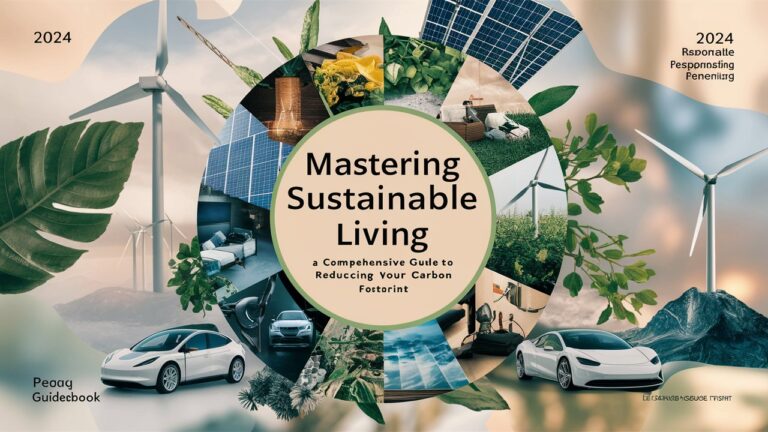Introduction: The Urgency of Sustainable Living in 2024
As climate change accelerates and global ecosystems face unprecedented strain, adopting sustainable living practices has transitioned from a niche lifestyle choice to an urgent global imperative. In 2024, the conversation around sustainability is no longer limited to recycling or energy-efficient lightbulbs; it encompasses systemic changes in how we consume, travel, eat, and interact with our environment. This article explores actionable strategies, emerging trends, and practical tools to help you reduce your carbon footprint effectively. Whether you’re a seasoned eco-advocate or a newcomer to sustainability, this guide offers insights to align your daily habits with the planet’s needs.
1. Understanding Sustainable Living: Foundations and Core Principles
1.1 Defining Sustainability in Modern Contexts
Sustainable living involves meeting present needs without compromising future generations’ ability to meet theirs. In 2024, this concept extends beyond individual actions to include systemic shifts in industries like agriculture, energy, and transportation. Key pillars include reducing waste, conserving natural resources, and prioritizing renewable energy. For instance, the circular economy—a model emphasizing reuse and regeneration—has gained traction as businesses and consumers reject the “take-make-dispose” mindset.
1.2 The Science Behind Carbon Footprints
A carbon footprint measures the total greenhouse gas emissions caused directly or indirectly by an individual, organization, or product. In 2024, tools like AI-powered carbon calculators enable precise tracking of emissions from daily activities, such as commuting, dietary choices, and home energy use. Understanding your footprint is the first step toward mitigating it. For example, a plant-based diet can reduce personal emissions by up to 73%, while switching to renewable energy providers can slash household carbon output by 40%.
2. Practical Strategies for Reducing Your Carbon Footprint
2.1 Energy Efficiency at Home and Beyond
Transitioning to renewable energy sources like solar or wind power is a cornerstone of sustainable living. In 2024, government incentives and falling technology costs make solar panel installations more accessible. Beyond energy production, simple changes—such as using smart thermostats, insulating homes, and opting for ENERGY STAR-rated appliances—can cut energy consumption by 30%. Additionally, microgrid communities, which generate and share renewable energy locally, are emerging as a revolutionary way to decentralize power systems.
2.2 Sustainable Diet and Food Systems
Food production accounts for 26% of global emissions. Adopting a plant-centric diet, reducing food waste, and supporting regenerative agriculture are critical steps. In 2024, vertical farming and lab-grown meat are reducing land use and methane emissions. Meanwhile, apps like Too Good To Go connect consumers with surplus food from restaurants and grocery stores, tackling the 1.3 billion tons of food wasted annually.
2.3 Eco-Friendly Transportation and Urban Planning
Electric vehicles (EVs) dominate headlines, but sustainable transportation also includes biking, public transit, and walkable cities. In 2024, EV infrastructure has expanded, with charging stations integrated into highways and workplaces. Car-sharing platforms and “15-minute cities”—urban designs where residents access essentials within a short walk or bike ride—are reducing reliance on fossil fuels.
3. Emerging Trends in Sustainability for 2024
3.1 Green Technology Innovations
Breakthroughs in carbon capture, green hydrogen, and biodegradable materials are reshaping industries. For example, startups are now using algae-based packaging to replace single-use plastics, while carbon-neutral cement offers hope for decarbonizing construction.
3.2 Policy and Corporate Accountability
Governments worldwide are enacting stricter climate policies, such as carbon taxes and bans on single-use plastics. Corporations, pressured by consumers and investors, are adopting ESG (Environmental, Social, Governance) frameworks. In 2024, transparency in supply chains and carbon offset programs are no longer optional but expected.
4. Measuring Impact: Tools and Metrics for Success
4.1 Carbon Tracking Apps and Platforms
Apps like Joro and Klima analyze spending habits to estimate emissions and suggest reductions. Meanwhile, blockchain technology is being used to verify the authenticity of carbon credits, ensuring accountability in offset programs.
4.2 Community Engagement and Advocacy
Individual actions matter, but collective efforts drive systemic change. Joining local sustainability groups, participating in climate strikes, or advocating for green policies amplifies impact. Platforms like Earth Hero offer templates for lobbying elected officials or organizing community cleanups.
5. Overcoming Challenges: Common Barriers to Sustainable Living
5.1 Cost and Accessibility
While sustainable products often carry higher upfront costs, long-term savings (e.g., lower energy bills) and secondhand markets mitigate financial barriers. Governments are also expanding subsidies for EVs, solar panels, and energy-efficient retrofits.
5.2 Navigating Greenwashing
As demand for eco-friendly products grows, so does greenwashing—misleading claims about sustainability. Certifications like Fair Trade, B Corp, and Energy Star help consumers identify genuine commitments.
Conclusion: Building a Sustainable Future Starts Today
Sustainable living in 2024 is not about perfection but progress. By integrating energy-efficient practices, supporting green innovations, and advocating for systemic change, individuals can contribute meaningfully to global climate goals. The journey requires persistence, education, and community, but the rewards—a healthier planet and resilient ecosystems—are immeasurable.
Frequently Asked Questions (FAQs)
Q1: Is sustainable living expensive?
While some eco-friendly products cost more initially, many strategies (e.g., reducing waste, using public transit) save money over time. Government incentives and secondhand markets also lower costs.
Q2: Can individual actions really make a difference?
Yes! Collective individual shifts drive demand for sustainable policies and products. For example, the global rise in veganism has pushed food companies to invest in plant-based alternatives.
Q3: How do I stay motivated?
Set achievable goals, track progress with apps, and connect with like-minded communities. Celebrate small wins, like reducing monthly energy bills or growing a vegetable garden.
Q4: What’s the quickest way to reduce my carbon footprint?
Switch to renewable energy, reduce meat consumption, and minimize air travel. These three steps alone can cut personal emissions by over 50%.
Q5: How can I avoid greenwashing?
Research brands’ sustainability claims, look for third-party certifications, and prioritize companies with transparent supply chains.
This guide equips you with the knowledge and tools to embrace sustainable living in 2024. By taking deliberate steps today, you become part of a global movement shaping a greener tomorrow.
